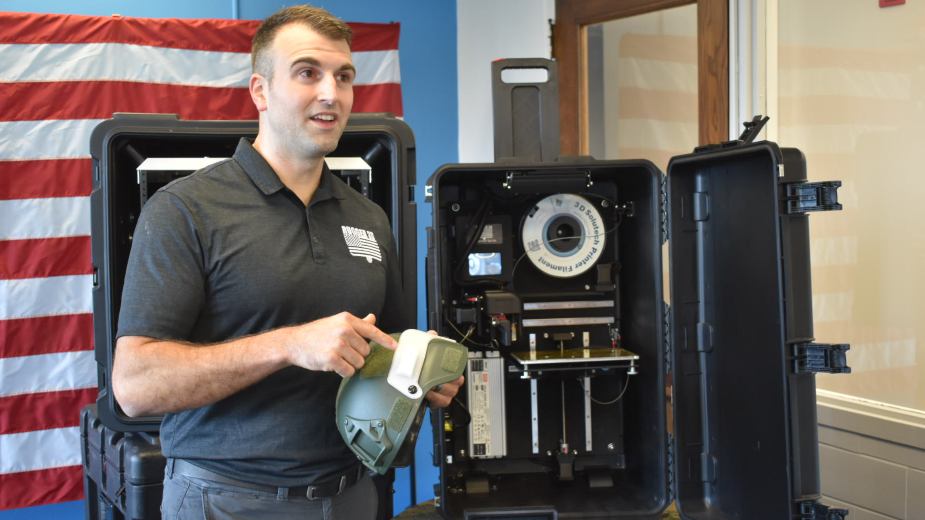Rugged 3D Builds ‘Ruggedized’ 3D Printers for Military Use
YOUNGSTOWN, Ohio – The additive manufacturing ecosystem that developed around America Makes was the primary factor that lured a San Francisco-based 3D printer startup to the Youngstown Business Incubator, the company’s founder said.
Rugged 3D, which manufactures “ruggedized” portable 3D printers that are designed for use in austere environments such as war zones, occupies about 1,000 square feet of space in YBI’s Tech Block Building No. 5. The company is assembling the printers at YBI and manufacturing components at another northeastern Ohio location, with plans to eventually consolidate both operations to the headquarters at YBI.
During Tuesday’s daylong virtual Lordstown Economic Recovery Initiative’s Regional Economic Diversification Summit, YBI and America Makes officials announced Rugged 3D had moved into the building.
“We need to address the core problem in 3D printing. The machinery itself has not been ruggedized and is not meant to be forward deployable and hardened,” said Collin Boring, Rugged 3D’s chief technology officer, during a news conference at YBI. “That’s what Rugged 3D is doing.”
The printers are encased in hardened casings and the printers inside are tethered by a multipoint suspension system to absorb impact.
Boring founded Rugged 3D in April 2019 with his brother, Tyler, a pilot who served in the U.S. Marine Corps. Tyler Boring told his brother that his helicopter was being grounded frequently for lack of parts that could have been 3D printed in the field, he said.
The problem was getting the printers into the field, and the systems the military currently uses aren’t doing the job. In some cases, they’re breaking apart the printers into cases and shipping them, with the pieces sometimes being broken in transit or some parts getting lost. Printers whose parts arrive complete and intact still take hours to assemble sometimes.
The alternative — packing the printer in a shipping container along with an air conditioner, a generator or other pieces requires trucks and airplanes to transport the container to a forward operating base — is “not a good solution either,” Boring said.
Boring decided to move the company from the San Francisco area, “a tech capital of the world” surrounded by venture capital and digital technologies, because it didn’t fit in there.
“We needed to be surrounded by people, businesses and an ecosystem that supports additive manufacturing,” he said. The additive manufacturing ecosystem created by YBI, America Makes, Youngstown State University and the regional business community “does not exist anywhere else in the country,” he remarked.
Barb Ewing, YBI’s CEO, recalled discussions going back to America Makes’ arrival on the YBI campus eight years ago about the future of additive manufacturing. The “holy grail” at the time was getting 3D printers into the field to help warfighters solve these problems regarding parts and tools, she said.
“This really is a quantum leap forward in terms of actual production opportunity for the military,” she said.
“This is a space that is very interesting to us. We do a considerable amount with the Department of Defense,” John Wilczynski, America Makes’ executive director. “The problems that they are addressing are directly in line with things that we’re seeing.”
The company, which has two employees, is producing two models so far.

The Commuter series, which weighs about 62 pounds, comes in a hard suitcase-type shell with a handle and wheels that can be transported as airline cargo or parcel.
At 110 pounds, the more durable Voyager series utilizes a military-grade case that can be air-dropped. A water chilling package allows it to operate in temperatures of 130 degrees Fahrenheit.
The printers can be used to produce an array of products, from replacements for broken power buttons to helmet attachments to hold flashlights or communications gear.
Additive manufacturing remains new for the military, though some branches are further along than others in its adoption, Boring said. Parts could be made using pre-designed patterns utilizing computer-aided design, or someone with CAD skills could design or modify a needed part.
“We’re also working on multiple other 3D-printing platforms,” Boring said.
One is a four-cubic foot pellet-fed printer that also would be capable of wire-fed metal printing and post-process CNC machining inside a modular, ruggedized crate.
The second platform would utilize explosive material for printing bombs, grenades or mission-specific improvised explosive devices, “things that are very critical to the military where you don’t get a do over and you need to be able to have that capability in the field,” he said. Prototyping for both should be finished by the end of 2021.
Boring plans to add two more employees by the end of the year and plans to employ up to eight by the end of 2021. It plans to expand to 5,000 square feet at YBI and bring the component manufacturing operation once there following a planned renovation of TBB5.
With the addition of Rugged 3D, all but a small office space is being occupied of the total 40,000 square feet of space renovated in the building three years ago. That leads to the “next phase” of the building’s development, Ewing said.
“We cannot expect to grow young companies like Rugged 3D and Juggerbot 3D and the other companies that we have in this building without having the space available,” she said. YBI is preparing an application to the U.S. Economic Development Administration for grant funds to renovate an additional 18,000 square feet of the 65,000-square-foot building.
Pictured at top: Collin Boring, Rugged 3D chief technology officer.
Copyright 2024 The Business Journal, Youngstown, Ohio.



